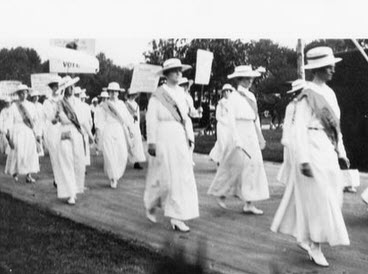
National League History
In her address to the National American Woman Suffrage Association's (NAWSA) 50th convention in St. Louis, Missouri, President Carrie Chapman Catt proposed the creation of a "league of women voters to finish the fight and aid in the reconstruction of the nation." The next year, on February 14, 1920— six months before the 19th Amendment to the Constitution was ratified—the League was formally organized in Chicago as the national League of Women Voters. Maud Wood Park became the first national president of the League and steered the women's suffrage amendment through Congress in the last two years before ratification.
From the very beginning, however, it was apparent that the legislative goals of the League were not exclusively focused on women's issues and that citizen education aimed at all of the electorate was in order. Since its inception, the League has helped millions of women and men become informed participants in government. The first League Convention voted 69 separate items as statements of principle and recommendations for legislation. Among them were protection for women and children, rights of working women, food supply and demand, social hygiene, the legal status of women, and American citizenship. The League's first major national legislative success was the passage of the Sheppard-Towner Act, which provided federal aid for maternal and child care programs.
Clackamas County League History
The League of Women Voters has worked since 1920 to improve our system of government and impact public policies through citizen education and advocacy. Today's LWVCC was founded in 1938 when a Clackamas County committee was established to further League purposes in the area following the 1920 establishment of the National and the Oregon League of Women Voters. Out of this committee came the Oswego area League and Milwaukie area League. These two Leagues eventually represented West Clackamas County (LWVWCC) and Milwaukie-East Clackamas County (LWVMECCA) respectively. Then in 2002, the two Leagues merged to form LWVCC, providing LWV service to the entire county.
The portfolios of the first board of directors indicate the extent of LWV Clackamas County's policy interests at the time: natural resources, welfare, finance, international trade, civil rights, education, housing, and government structure. Over 80 years later, LWVCC attracts members from many areas of the county who advocate for just as wide a range of policies as it did when it was founded.
Today's LWVCC began around 1938 when a Clackamas County committee was established to further League purposes in the area following the 1920 establishment of the National and the Oregon League of Women Voters. Out of this committee came the Oswego area League and Milwaukie area League. These two Leagues eventually represented West Clackamas County (LWVWCC) and Milwaukie-East Clackamas County (LWVMECCA) respectively. Then in 2002, the two Leagues merged to form LWVCC, providing LWV service to the entire county. For example, our early activism included playing an important role in the establishment of Tryon Creek as an urban State Park in 1970 and in the policy work in Lake Oswego's first and subsequent Comprehensive Plans.